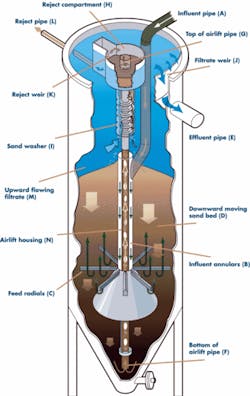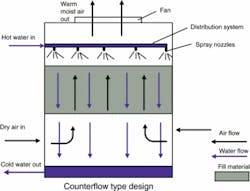Continuous Backwash for Side Stream Filtration
By Mohamed Ahmed Salah, P.Eng.
In desert and arid environments such as the Middle East where dust is a major problem, side stream filtration helps maintain cooling water systems whether for power plants, oil refineries, chemical processing or commercial buildings.
Cooling towers are heat rejection devices that extract waste heat to the atmosphere through the cooling of a water stream to a lower temperature. They represent a relatively inexpensive and dependable means of removing low-grade heat from cooling water. They’re evaporative coolers that cool water to near ambient temperature. Heat is dissipated through the natural process of evaporation that takes place when air and water are brought into direct contact in the cooling tower. Common applications include cooling the circulating water used in oil refineries, chemical process industries, power plants and building cooling.
Suspended Solids in Cooling Tower
The water of evaporation exits the tower in a pure vapor state leaving behind its burden of total dissolved solids (TDS) and total suspended solids (TSS) to concentrate in the re-circulating mass of water. Given no control, the TDS level in the circulating water will increase tremendously jeopardizing not only the cooling tower, but the heat exchangers and all other water circuit related components. Bear in mind, cooling towers make excellent air scrubbers/washers. Due to the high volume of air passed through, most contaminants in the air end up in the cooling water basin. Some contaminants are dirt, grit, sand, slime and algae. Other sources that contribute solids in the cooling tower include chemical residues and calcium scale flake off. Chemical feed is made for the purpose of corrosion protection, microbiological control and to increase the solubility of mineral salts. Depending on the location of the open loop cooling tower up to 4 lbs. of debris per ton can be cleaned from the air into the cooling water system per year. This can reduce system operating efficiency and can increase maintenance and cleaning requirements
Solid contaminants can clog cooling tower spray nozzles resulting in poor water distribution through the fill. Most countercurrent cooling towers use pressurized spray distribution systems. The spray nozzles often have small orifices that clog easily. Deposits on heat transfer surfaces also increase the fouling factor that significantly decreases transfer efficiency.
To maintain efficient cooling tower operation, solid contaminant levels have to be reduced. One way is to bleed off (blowdown) a portion of the re-circulating water on a regular basis. In addition to blowdown, filtration of a partial stream of circulating water is necessary to reduce the content of suspended solids.
Figure 1 shows a typical cooling tower recirculation loop. With side stream filtration, a portion of the water is filtered continuously. This works on the principal that continuous suspended solids removal will keep water flowing through the system at about less than 20 ppm all the time. In places like the Middle East where there are sand storms, side stream filtration becomes necessary to remove the high loads of suspended solids.
Side Stream Filtration
In side stream filtration, a small portion (15-20%) of the cooling water is continuously filtered and returned to the system to remove suspended solids from cooling tower systems. The main technologies used are pressure sand filtration and gravity continuous backwash filtration. The latter is particularly suitable for cases where large capacities are involved and the system could be easily coupled with the cooling water reservoir.
Parkson Corp.’s DynaSand continuous backwash filter is widely used for side stream filtration. It is an upflow, deep-bed, granular media filter with continuous backwash. The filter media is cleaned by simple internal washing system that doesn’t require backwash pumps and storage tanks. The absence of backwash pumps means low energy consumption. One of the key advantages of continuous backwash filter is its ability to withstand high solids loading rate while maintaining constant pressure drop.
In the following paragraph, we will describe how the continuous backwash filtration system works, as illustrated in the figure on the previous page. Influent is introduced into the filter through the feed inlet pipe (A) and flows down through the feed assembly pipe (B). Then, the flow enters into horizontal distributors, also called radial arms (C), which protrude into the filter. These distributors allow even distribution of the influent into the sand bed. The influent is then filtered upward through the sand. During this upward filtration, the sand bed (D) constantly moves downward and clean filtrate exits from the sand bed through an effluent pipe (E).
An internal airlift (F) transports a portion of the contaminated sand media and discharges to a reject bowl/chamber (H) at the top of the filter unit. The agitation and turbulence within the airlift clean the sand of the filtered solids. Due to gravity the sand, which is heavier than the organic solids, captured in the bed falls down through sand washer (I).
The washer/central compartment section is isolated from the filtrate, except where the sand exits at the bottom of the washer. Treated effluent flows over the effluent weir (J) and the reject flow over a reject weir (K), leaving the system through a reject pipe (L).
During sand storms, especially arid environments such as in the Middle East, self-cleaning deep bed filter becomes necessary to maintain the desired suspended solids in the cooling tower water loop.
Comparing with other available technologies, sand filtration with continuous backwash seems to be the right technology for side stream filtration.
WWi
Author’s Note:
Mohamed Ahmed Salah, P.Eng., is a regional manager with the Parkson Corp. A subsidiary of Axel Johnson Inc., Parkson is a supplier of solutions for potable water, process water, and industrial and municipal wastewater treatment. With multiple offices the USA, Canada, Brazil and the United Arab Emirates, it’s based in Fort Lauderdale, Florida, USA. Salah operates from Florida and Dubai. Contact: [email protected] or www.parkson.com


